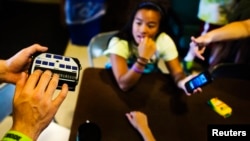A deaf and blind woman from Australia has become the first person to make a telephone call using a device that converts speech into Braille. Braille is a form of writing that uses raised dots on a surface that can be “read” by touching it.
The technology is being tested for the first time in Australia and the United States. One test involved a simple phone call between two sisters.
Michelle Stevens is deaf and blind. Ms. Stevens says the braille telephone will end years of feeling isolated, or feeling alone and apart from others. She is one of five Australians who is taking part in the new trials, or tests. These trials will take place at about the same time in Australia and the United States, where the technology was developed.
Ms. Stevens' vision suffered damage because she was born prematurely, or born too soon. She lost her hearing from serious ear infections.
The Braille telephone system, she said, will be a great help to her and others.
Ms. Stevens told VOA’s Phil Mercer that this telephone system will be one way to break the isolation of deaf-blindness. She adds that with future developments, the phone system might be able to give deaf-blind people more job opportunities. Not being able to communicate in the office or on the telephone is a major employment barrier for people who are deaf-blind said Ms. Stevens.
However, the phone system is expensive. It costs about $2,500. The phones work by transferring spoken words onto what is called a "dynamic braille display."
A similar trial will also take place in the United States in a few months. Christopher Engelke is a director with the U.S. company Ultratec. He will carry out the trial in the U.S.
How does it work?
Mr. Engelke says the Braille phone system is an exciting project. He describes the system this way: a deaf person, or one who is hard of hearing, uses the phone just like any other phone. However, subtitles or captions of what is said appear on the phone’s touch screen.
“The way that the whole system works is a deaf, or hard of hearing person, who speaks for themselves, would use the phone just like any other phone, except that much like getting subtitles on your TV, you get subtitles or captions to the conversation appearing on the screen, although for a Braille user they could read those captions in Braille bumps on a dynamic Braille display. So they would listen to as much as they can, speak with their own voice and then read everything that is being said to them by reading the Braille on the phone itself.”
Mr. Engelke explains that vision-impaired people would listen to as much as they can, speak with their own voice and read everything that is being said to them from the Braille bumps on the phone.
Developers of the device say it could change the lives of those who cannot see or hear. In Australia alone, it is estimated there are 330,000 people who are deaf and blind. Some groups say that number is likely to reach 1.2 million by 2050.
I’m Anna Matteo.
Phil Mercer reported this story from Sydney, Australia, for VOA News. Anna Matteo adapted it for Learning English. Mario Ritter was the editor.
______________________________________________________________
Words in This Story
Braille - n. a system of writing for blind people in which letters are represented by raised dots
trial - n. a test of the quality, value, or usefulness of something
parallel - adj. moving in the same direction, side-by-side or taking place at the same time
hard of hearing - adj. relating to or having a defective but working sense of hearing
caption - n. a sentence or group of words that is written on or next to a picture to explain what is being shown






